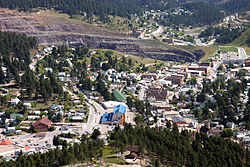Lead, South Dakota
| Lead | |
|---|---|
| City | |
| Lead, South Dakota | |

Aerial photo of Lead
|
|
 Location in Lawrence County and the state of South Dakota |
|
| Coordinates: 44°21′3″N 103°45′57″W / 44.35083°N 103.76583°WCoordinates: 44°21′3″N 103°45′57″W / 44.35083°N 103.76583°W | |
| Country | United States |
| State | South Dakota |
| County | Lawrence |
| Incorporated | 1890 |
| Area | |
| • Total | 2.06 sq mi (5.34 km2) |
| • Land | 2.06 sq mi (5.34 km2) |
| • Water | 0 sq mi (0 km2) |
| Elevation | 5,213 ft (1,589 m) |
| Population (2010) | |
| • Total | 3,124 |
| • Estimate (2015) | 2,999 |
| • Density | 1,516.5/sq mi (585.5/km2) |
| Time zone | Mountain (MST) (UTC-7) |
| • Summer (DST) | MDT (UTC-6) |
| ZIP code | 57754 |
| Area code(s) | 605 |
| FIPS code | 46-36220 |
| GNIS feature ID | 1265276 |
| Website |
http://cityoflead.com/ www |
|
Lead Historic District
|
|
| Location | Roughly bounded by the Lead city limits |
|---|---|
| Coordinates | 44°21′6″N 103°45′45″W / 44.35167°N 103.76250°W |
| Area | 580 acres (230 ha) |
| Built | 1880 |
| Architectural style | Greek Revival, Hip cottage |
| NRHP Reference # | 74001892 |
| Added to NRHP | December 31, 1974 |
Lead (/ˈliːd/ LEED) is a city in Lawrence County, South Dakota, United States. The population was 3,124 at the 2010 census. Lead is located in western South Dakota, in the Black Hills near the Wyoming state line.
The city was officially founded on July 10, 1876, after the discovery of gold. The city was named for the leads or lodes of the deposits of valuable ores. It is the site of the Homestake Mine, the largest, deepest (8,240 feet [2,510 m]) and most productive gold mine in the Western Hemisphere before closing in January 2002. By 1910, Lead had a population of 8,382, making it the second largest town in South Dakota.
Lead was originally founded as a company town by the Homestake Mining Company, which ran the nearby Homestake Mine. Phoebe Hearst, wife of George Hearst, one of the principals, was instrumental in making Lead more livable. She established the Hearst Free Public Library in town, and in 1900 the Hearst Free Kindergarten. Phoebe Hearst and Thomas Grier, the Homestake Mine superintendent, worked together to create the Homestake Opera House and Recreation Center for the benefit of miner workers and their families. Phoebe Hearst donated regularly to Lead's churches, and provided college scholarships to the children of mine and mill workers.
...
Wikipedia


